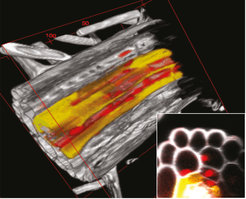Root Communication with the Environment
How do Roots communicate with their environment?
Most agricultural traits are based on above-ground features (amount of seeds, plant height, weight, etc.). However, the plant-associated underground is likely to contain many traits that influence overall plant health. Roots are faced with constant stress both regarding nutrient/water availability and biotic factors such as pathogenic microbes, and needs to respond accordingly to survive. The root needs to create the right response at a cellular level, and the amplitude of stress factors varies dramatically across the root system. The plant therefore needs to continuously integrate and monitor what each and every one of its cells perceive of its surroundings. While we have some understanding on how these incredibly complex emerging outputs are coordinated within entire root system, we still don’t understand how this is coordinated on a single-cell-level.

A passage cell and associated “hub” expression pattern in Arabidopsis thaliana.
Cell outlines are seen in grey, suberized endodermal cells in yellow. The red colour depicts expression of a gene that is present in the vasculature, but spreads into the passage cell and surrounding cells in the outer cortex layer. The insert shows a cross section of the root in the place of the passage cell.
Recent data suggest that specific cells, termed “Passage cells” might serve as communication hubs between the root and the outer environment (Figure 1) (Andersen et al. 2018). These cells occur specifically in the xylem pole of roots and respond to nutrient deficiencies. This suggests that the xylem pole of roots might play an important role in how plants sense and interact with their surroundings in the soil. In our group, we primarily use these passage cells as well as the xylem pole as a model to study development and (a)biotic functions of the root xylem pole cell-specific root communication.
To achieve this, we employ high-end fluorescence-based microscopical techniques, near-native physiological setups, microfluidics, transcript- and translatomics as well as microbiome-based community studies. This allow us to dig deep into how specialized communication occur between plants, the soil and the associated microbiota. We mainly work with the plant Arabidopsis thaliana, with its strong genetic toolbox, allow us to study gene expression at single-cell resolution as well as a well-characterized microbiome. However, as part of our research is focussed on how microbial associations and plant structures form and are connected to the plants transport systems, we also use Lotus japonicus as model system. Lotus form highly specialized mutually beneficial associations with bacteria, which, in exchange for sugar, provide the plant with nitrogen. These associations depend on special root structures called nodules that develop specifically in the xylem pole.
Understanding how plants use the xylem pole to can be used to optimize plant health and yield. From an agricultural perspective, Insight into how plants communicate with the surroundings can provide a more efficient usage of nutrients and a stronger resistance to diseases. Thus, investigations in this field would not only allow us to grow more food in less space, but do so with less use of artificial fertilizers.
